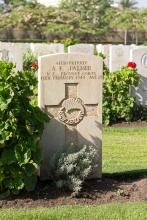"Born in Upper Hutt, Alexander Palmer was known locally as ‘Jim’, and was raised by his parents Francis and May, alongside his younger sister Avis on their farm at Mangaroa. He was working there on the family farm as a farmhand, as the clouds of war began to gather.
Jim enlisted into the Territorial Army as a Private with the Army Service Corps in 1938. He was still serving when conflict broke out and volunteered for overseas service, being attested in mid-July 1940. Despite lying and adding a year to his age, he had to wait another six months before being called into camp at Trentham on 7 January 1941.
Posted to 32 Infantry Battalion, Jim underwent four months of initial training, before boarding His Majesty’s Transport (HMT) No.25 Mauretania on 7 April 1941. The convoy sailed from Wellington Harbour as part of the 5th Reinforcements, escorted by HMS Achilles, HMAS Australia and HMAS Hobart on route to Sydney.
After transiting through Fremantle in Western Australia and Colombo in Ceylon (now Sri Lanka), Jim and his mates arrived at Port Tewfik, Suez on 13 May 1941. The fresh reinforcements then travelled by train to Cairo, from where they were transported to Maadi Camp, the main 2nd New Zealand Expeditionary Force base in the Middle East.
Jim was at first posted to Headquarters of 5th (NZ) Infantry Brigade, before being allocated as a reinforcement for 23 Battalion, which had initially been drawn from Territorial Force units in Canterbury and Otago. The unit was rebuilding after the recent losses suffered in Greece and Crete.
After a short stint in the 2nd New Zealand General Hospital, Jim commenced training with the Infantry Training Depot in preparation for service in the Western Desert. It is unclear what the outcome of this training was, but six weeks later Jim was posted to the New Zealand Field Punishment Centre in Maadi Camp as a clerk.
The Field Punishment Centre was run by the New Zealand Provost Corps, and provided commanders an option to punish those who had committed an offence while on active service, for which the traditional confinement to barracks and extra fatigues administered by the Battalion orderly room, was not considered sufficient.
A Commanding Officer could sentence a soldier to service at the Field Punishment Centre for between 7 and 28 days. Here defaulters were locked up and subject to hard labour, sometimes while restrained in irons. For more serious crimes, which would have normally drawn a civilian conviction, or for desertion or sleeping while on sentry, individuals would be sent to the Detention Barracks at the Citadel or at Abbassia.
While staff at the New Zealand Field Punishment Centre were not exactly popular amongst other Kiwi soldiers, it was generally thought more fitting be punished by a fellow countryman, than the ‘Red Caps’ of the British Military Police.
Jim served for two years at Maadi, and ended up formally becoming part of the New Zealand Provost Corps. While his work as a clerk wasn’t exactly glamourous, he received an extra shilling each day as extra duties pay, except for the short period where he went on leave in May 1943.
Unfortunately, Jim became ill in mid-September 1943 and was admitted to the 23rd New Zealand Field Ambulance. From there he was transferred to the New Zealand Convalesce Depot, and when things became more serious back to the Field Ambulance.
Jim had been sick for nearly five months when he was placed on the dangerously ill list on 9 February 1944, as he suffered with inflammation of his kidneys due to viral glomerulonephritis. Sadly his condition worsened, and he did not recover. Jim Palmer passed away from sickness on 13 February.
Just 23 years old when he was buried with full military honours in Heliopolis War Cemetery in Egypt. Jim’s parents were heartbroken at the loss of their only son, and Avis devastated at the loss of her brother. In commemoration a memorial plaque was added to the family headstone in St. John’s churchyard in Trentham. The Friends of St John’s Trentham Trust Board and the NZ Remembrance Army continue to ensure his memory is well preserved today." [Source: https://www.facebook.com/UpperHuttWarStories/, accessed 15/10/2021]


